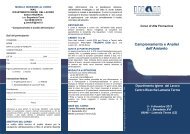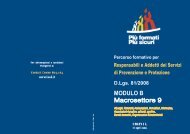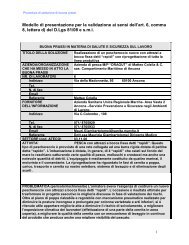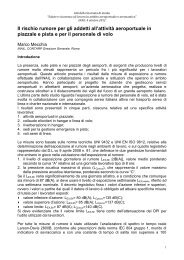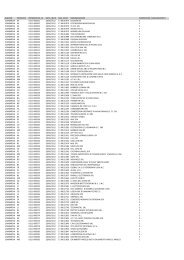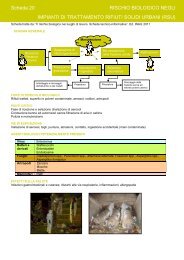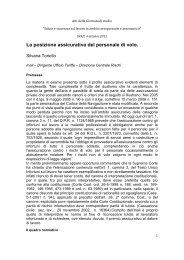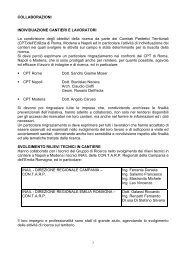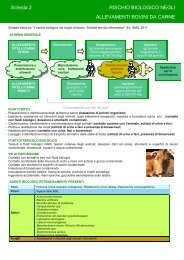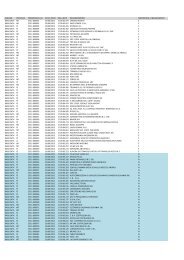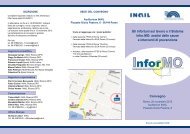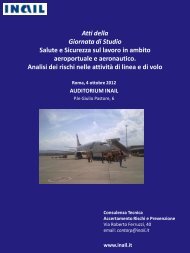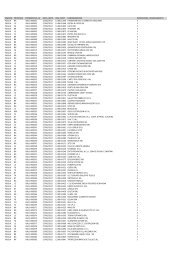il rischio da vibrazioni al corpo intero per le attivita' svolte sui mezzi ...
il rischio da vibrazioni al corpo intero per le attivita' svolte sui mezzi ...
il rischio da vibrazioni al corpo intero per le attivita' svolte sui mezzi ...
- No tags were found...
You also want an ePaper? Increase the reach of your titles
YUMPU automatically turns print PDFs into web optimized ePapers that Google loves.
Atti della Giornata di studio<br />
“S<strong>al</strong>ute e sicurezza sul lavoro in ambito aeroportu<strong>al</strong>e e aeronautico”<br />
INAIL 4 ottobre 2012<br />
Si osservano <strong>vibrazioni</strong> maggiori nella condizione di volo (che corrispondono a tempi critici più<br />
bassi).<br />
Aeromob<strong>il</strong>i<br />
I risultati relativi agli aeromob<strong>il</strong>i dipendono molto <strong>da</strong>l<strong>le</strong> fasi e <strong>da</strong>l<strong>le</strong> condizioni di navigazione , ma<br />
sono in gener<strong>al</strong>e di tutta sicurezza.<br />
Nel<strong>le</strong> condizioni di crociera (con turbo<strong>le</strong>nze assenti o minime) sono stati misurati v<strong>al</strong>ori di<br />
acce<strong>le</strong>razione estremamente bassi (<strong>da</strong> 0,01 a 0,04 m/s 2 ), mentre in presenza di turbo<strong>le</strong>nza<br />
sono stati registrati v<strong>al</strong>ori di circa 10 volte su<strong>per</strong>iori.<br />
Una premessa a questa particolare tipologia di esposizione è che la durata dell‟<strong>intero</strong> volo può<br />
essere considerata come un tempo di esposizione massimo, ma non lontano <strong>da</strong>l tempo di<br />
esposizione effettivo.<br />
Questo <strong>per</strong>ché, pur dovendo quest‟ultimo escludere gli interv<strong>al</strong>li in cui <strong>il</strong> p<strong>il</strong>ota si <strong>al</strong>za <strong>da</strong>l sed<strong>il</strong>e,<br />
t<strong>al</strong>i pause <strong>da</strong> un lato risultano t<strong>al</strong>mente ridotte <strong>da</strong> risultare poco significative rispetto <strong>al</strong>la durata<br />
del volo, <strong>da</strong>ll‟<strong>al</strong>tro non affrancano <strong>il</strong> p<strong>il</strong>ota <strong>da</strong>ll‟esposizione a <strong>vibrazioni</strong>, che si verifica<br />
ugu<strong>al</strong>mente attraverso mo<strong>da</strong>lità differenti: ad esempio attraverso i piedi, nella posizione eretta.<br />
La precedente considerazione v<strong>al</strong>e, a maggior ragione, <strong>per</strong> <strong>il</strong> <strong>per</strong>son<strong>al</strong>e di assistenza <strong>al</strong> volo.<br />
In definitiva, a favore della sicurezza, si può assim<strong>il</strong>are la durata dell’<strong>intero</strong> volo <strong>al</strong> tempo<br />
di esposizione effettivo.<br />
Nei “campionamenti” effettuati, la durata massima di volo è stata pari a circa 14 ore <strong>al</strong> netto dei<br />
tempi di attesa a terra.<br />
I tempi critici di azione t cr az relativi <strong>al</strong><strong>le</strong> misure relative <strong>al</strong>l‟<strong>intero</strong> volo risultano sempre su<strong>per</strong>iori<br />
<strong>al</strong><strong>le</strong> 30 ore, mentre quelli relativi <strong>al</strong><strong>le</strong> misure parzi<strong>al</strong>i più pen<strong>al</strong>izzanti, risultano sempre su<strong>per</strong>iori<br />
<strong>al</strong><strong>le</strong> 20 ore, su<strong>per</strong>ando abbon<strong>da</strong>ntemente i tempi massimi di esposizione possib<strong>il</strong>i (12 – 14 ore,<br />
nel<strong>le</strong> tratte considerate), garantendo <strong>per</strong>tanto esposizioni giorn<strong>al</strong>iere A(8) decisamente inferiori<br />
<strong>al</strong> v<strong>al</strong>ore d‟azione del D.Lgs 81/08.<br />
Grazie anche a questa circostanza, si può escludere, <strong>per</strong> gli aeromob<strong>il</strong>i presi in considerazione<br />
e in condizioni di relativa norm<strong>al</strong>ità di crociera (sim<strong>il</strong>i a quel<strong>le</strong> <strong>da</strong> riscontrate in occasione del<strong>le</strong><br />
misure <strong>svolte</strong>), l‟esistenza di <strong>rischio</strong> <strong>da</strong> <strong>vibrazioni</strong> a <strong>corpo</strong> <strong>intero</strong> <strong>per</strong> <strong>il</strong> <strong>per</strong>son<strong>al</strong>e di volo (p<strong>il</strong>oti,<br />
stuart, hostess), <strong>per</strong> durate di volo inferiori a circa 20 ore.<br />
Si deve <strong>per</strong><strong>al</strong>tro aggiungere che i v<strong>al</strong>ori più <strong>al</strong>ti di <strong>vibrazioni</strong> vengono trasmesse <strong>al</strong> <strong>corpo</strong><br />
durante <strong>le</strong> fasi di spostamento a terra dell‟aeromob<strong>il</strong>e (aggancio con mezzo di spostamento,<br />
rullaggio fino ad inizio pista, acce<strong>le</strong>razione prima del decollo e fasi an<strong>al</strong>oghe successive<br />
<strong>al</strong>l‟atterraggio).<br />
Essendo brevi <strong>le</strong> durate di queste fasi rispetto ai tempi di crociera, la loro incidenza sull‟intera<br />
esposizione risulta esigua, e comunque tanto minore quanto più lungo è <strong>il</strong> volo.<br />
Questo consente di ritenere <strong>al</strong>quanto improbab<strong>il</strong>i esposizioni che su<strong>per</strong>ino <strong>il</strong> v<strong>al</strong>ore d‟azione<br />
anche <strong>per</strong> voli più lunghi di 20 ore, <strong>per</strong> i qu<strong>al</strong>i, <strong>per</strong><strong>al</strong>tro, va considerata la turnazione dei p<strong>il</strong>oti<br />
che, in ragione del<strong>le</strong> “mo<strong>da</strong>lità di riposo” può ridurre <strong>il</strong> <strong>per</strong>iodo di esposizione.<br />
Nel caso del<strong>le</strong> tratte di lungo raggio, è comunque auspicab<strong>il</strong>e un approfondimento dell‟aspetto<br />
postur<strong>al</strong>e e della turnazione, a causa del mantenimento di posture statiche <strong>per</strong> lunghi <strong>per</strong>iodi.<br />
Non si può natur<strong>al</strong>mente escludere che, in condizioni straordinarie qu<strong>al</strong>i turbo<strong>le</strong>nze <strong>per</strong>sistenti o<br />
ripetute durante <strong>il</strong> volo, possano verificarsi condizioni di esposizione <strong>al</strong><strong>le</strong> <strong>vibrazioni</strong> ben più<br />
gravose di quel<strong>le</strong> r<strong>il</strong>evate.<br />
FENOMENO IMPULSIVO<br />
La norma UNI ISO 2631-1 prevede che la v<strong>al</strong>utazione dell‟esposizione a <strong>vibrazioni</strong>, quando <strong>il</strong><br />
fattore di cresta FC su<strong>per</strong>a <strong>il</strong> v<strong>al</strong>ore 9, debba includere l‟applicazione di uno dei metodi<br />
addizion<strong>al</strong>i ivi descritti, <strong>per</strong> la v<strong>al</strong>utazione del fenomeno impulsivo.<br />
5



